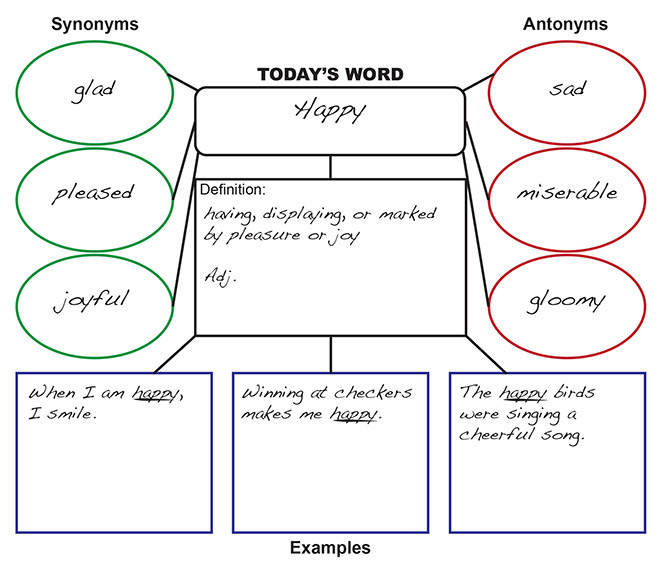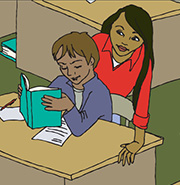How might Ms. Price provide help to meet the individual needs of all her students, including those with disabilities?
Page 3: Content Scaffolding
 One type of instructional scaffolding is referred to as content scaffolding. For this type of scaffolding, the teacher selects content that is not too difficult or unfamiliar for students learning a new skill. Doing so allows students to focus on the skill being taught and not get bogged down in the content. Three content scaffolding techniques are described below.
One type of instructional scaffolding is referred to as content scaffolding. For this type of scaffolding, the teacher selects content that is not too difficult or unfamiliar for students learning a new skill. Doing so allows students to focus on the skill being taught and not get bogged down in the content. Three content scaffolding techniques are described below.
Use Familiar or Highly Interesting Content
 Teachers often find that it is much easier to teach a new strategy to students when they begin with content that is familiar or highly interesting. Students taught a new strategy in this way tend to be more motivated to learn. Over time, the teacher will introduce content that is less and less familiar and will ask the students to apply the newly learned strategy to the content.
Teachers often find that it is much easier to teach a new strategy to students when they begin with content that is familiar or highly interesting. Students taught a new strategy in this way tend to be more motivated to learn. Over time, the teacher will introduce content that is less and less familiar and will ask the students to apply the newly learned strategy to the content.
Word Web
Word webs are graphic organizers that help students to better understand a key vocabulary term by connecting it to related terms.
Example

This vocabulary graphic organizer depicts different aspects of a word. In the center of the graphic organizer Today’s Word is listed. Today’s Word is “happy.” Under the word is the definition of happy: “having, displaying, or marked by pleasure or joy, adj.” Under the definition of happy are three examples of Today’s Word in sentences. The first example is “When I am happy, I smile.” The second example is “Winning at checkers makes me happy.” The third example is “The happy birds were singing a cheerful song.” To the left of Today’s Word are three synonyms for happy. The synonyms are “glad,” “pleased,” and “joyful.” To the right of Today’s Word are three antonyms for happy. The antonyms are “sad,” “miserable,” and “gloomy.”
(Close this panel)
As was mentioned above, Ms. Price has decided to teach her students a word-web strategy to help them to organize their thoughts on paper. She realizes that this will take some time away from her science curriculum but believes that, in the long run, it will actually save time and provide her students with an effective writing strategy. She begins by drawing a web on the board that helps her students to select their essay topics and the content of their three supporting paragraphs. Ms. Price decides to start the students off with an essay about themselves so that they do not have to struggle with the content but can instead focus on the task at hand: identifying the main topics of their essays. She models the strategy on the board, using herself as an example. Later, she models how to transform the information in the web into a five-paragraph essay. Once the students have mastered all the steps of the strategy with this familiar content, she will instruct them to use the strategy to write their science-fair essays.
Use Easy Content
This technique involves using content that is easy for the students in order to teach a new task or strategy at hand. This allows the students to better focus on the strategy. For example, say another teacher wishes to explain a reading-comprehension strategy to one of his students. He will initially use a text that is one or two grade levels below the student’s current reading level. This allows the student to use all of her energy to master the comprehension strategy. Then, after the student has developed confidence in the strategy, the teacher will gradually increase the difficulty of the passages.
Start With the Easy Steps
 One simple way to scaffold instruction is for the teacher to perform and model the more difficult steps of a task while letting students do the easier steps. Gradually, the students should take responsibility for completing the more difficult steps. During the learning process, the teacher continues to model and help the students with any problems they might have. For example, imagine that a first-grade reading specialist is teaching phonics to a student. She asks the student to read simple stories aloud. When he comes to a word with which he is having difficulty, the reading specialist will model sounding out the word. Next, she asks the student to read the sentence, including the difficult word, once again. As he masters the phonics strategy, the student will be expected to take more and more responsibility for sounding out new or unfamiliar words.
One simple way to scaffold instruction is for the teacher to perform and model the more difficult steps of a task while letting students do the easier steps. Gradually, the students should take responsibility for completing the more difficult steps. During the learning process, the teacher continues to model and help the students with any problems they might have. For example, imagine that a first-grade reading specialist is teaching phonics to a student. She asks the student to read simple stories aloud. When he comes to a word with which he is having difficulty, the reading specialist will model sounding out the word. Next, she asks the student to read the sentence, including the difficult word, once again. As he masters the phonics strategy, the student will be expected to take more and more responsibility for sounding out new or unfamiliar words.